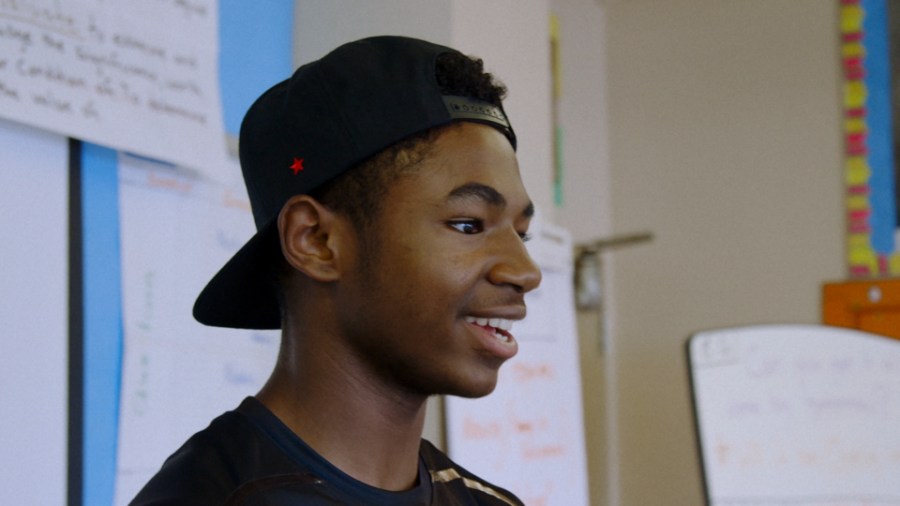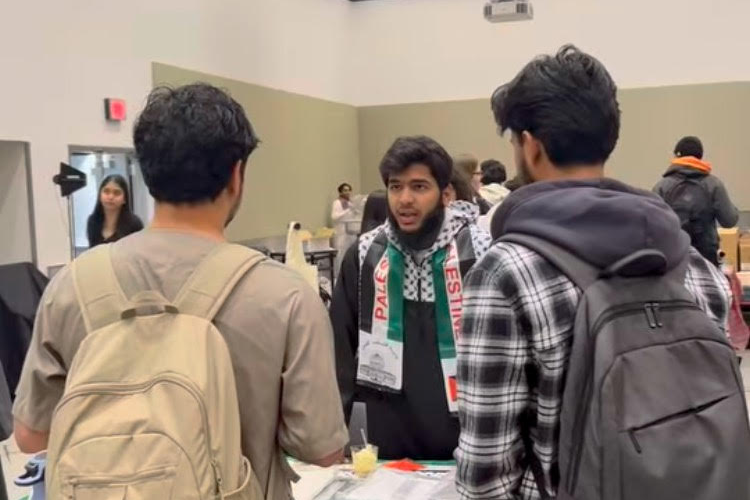Opinion: Testing abuses, legacy preferences and bad parent behavior all influence who gets into college: What must change?
Enoch Jemmott, a senior at Queens College featured in the documentary “Personal Statement,” has been speaking out publicly on the need for more school counselors to help low-income students with college admissions. Courtesy of Jesse Hicks. (Still image from PERSONAL STATEMENT)
June 20, 2019
NEW YORK — Whenever I see another person charged or sentenced in the latest college admissions scandal, I’m transported a few years back to a tortured college application season, when a testing snafu invalidated the SAT scores of my then-16-year-old son and the nearly 200 others who took the exam at the same site.
The reasons for this headache were never fully explained; we were told something about desks being too close together. Rescheduling became such a nightmare that my son refused to take the exam again. Who knew I could have simply paid someone extraordinary amounts of money to take it for him, or correct any wrong answers?
If I had the money or inclination, I could even have pushed for a fraudulent special needs diagnosis so he could receive extended time, just like the parents, coaches and others involved in this calculated (and illegal) scheme to get kids into top colleges.
The bribes, lies and cheating on display in the admissions scandal that has ensnared 50 people, including famous actresses and wealthy financiers, expose in stark terms the fallacy of college admissions as a meritocracy. Scales can tip in favor of donors, athletes and legacies; by some estimates these advantages double or quadruple an applicant’s chances of admission. Is there no end to how far parents with unlimited checkbooks and outsized expectations for their children will go?
Consider recent headlines like this: “Parents Gone Wild: High Drama Inside D.C.’s Most Elite Private School.” The story describes how a dean at coveted Sidwell Friends (annual tuition $42,372) excoriated parents to stop verbally assaulting college counselors and circulating rumors about other students — all in an effort to give their own children a leg up on admissions.
It gets worse: Erica Furda, dean of admissions at the University of Pennsylvania, recently recounted a theme he’s noticed after being inundated with angry phone calls from parents of rejected applicants. Some of them began their inquiries by questioning the achievements of a student they knew was admitted rather than advocating for their own child, Furda told journalist Jeff Selingo.
Meanwhile higher education is facing a far more meaningful supply and demand crisis. The country can’t produce more college graduates without getting more low-income students to and through college, yet poor teenagers with top scores are no more likely to earn degrees than mediocre-scoring students from well-off families.
Less than one-half of 1 percent of children from the poorest fifth of American families attend elite colleges and universities, according to one 2017 study. And vast inequities remain in both the enrollment and graduation rates for minority students, a recent American Council on Education report found.
“Right now, the system feels like it is crafted to keep low-income students like us out of college,” wrote Enoch Jemmott, a student at Queens College who is featured in the documentary “Personal Statement,” which we’ve partnered with at Hechinger. “That some rich families bribe their children’s way into college is the least of our problems.’’
I asked Jerome Lucido, executive director at the University of Southern California’s Center for Enrollment Research, Policy and Practice, how admissions can be fixed. It’s a topic he’s spent years thinking about: In 2011, Lucido helped put together a conference and a paper filled with recommendations for change; he worried that growing competition for elite schools would create illicit back doors.
All this was before USC became ground zero in the current scandal, before actress Lori Loughlin was charged on conspiracy to commit fraud and money laundering for allegedly paying $500,000 to ensure her two daughters were admitted to USC as rowing recruits.
With rejected students filing lawsuits, USC has vowed new scrutiny of some of its admissions practices, but Lucido acknowledges that big ticket reforms will be slow and incremental. Real change will only happen, he says, if colleges publish and become transparent “about the number of applications, admits, and enrollees by category at all schools, including donor children, alumni children, athletes, and other talent-based admissions.”
Ted Mitchell, a former U.S. undersecretary of education who now leads the American Council on Education, told me he’d like to see the public and policy makers focus less attention on highly selective schools and instead begin thinking about how to do more to help institutions that serve larger numbers of poor, minority students and first-generation students, including HBCUs, community colleges and regional public universities.
That would require paying more attention to a topic to which we devote much of our Hechinger Report coverage: the many ways higher education has become more segregated than ever by wealth and race, with merit aid increasingly going to wealthier students.
Students who could benefit greatly from rich offerings at top four-year colleges and don’t have wealthy parents micromanaging their educational paths are too often left out of the equation entirely.
“We spend way too much time talking about the one kid who got in because the Stanford sailing coach made a bad decision,” Mitchell said.
That Stanford University sailing coach, John Vandemoer, pleaded guilty to accepting bribes for the program in exchange for designating students who weren’t sailors as recruits to the Stanford sailing team; he was sentenced last week.
At private institutions like USC, recruited athletes clearly have an edge, and there’s also enormous pressure to admit sufficient numbers of students who can pay full freight and meet revenue targets. How such decisions are made are clearly explained in education writer Paul Tough’s insightful new book, “The Years That Matter Most: How College Makes or Breaks Us.”
Tough looks at Trinity College in Connecticut, long a bastion of wealth and privilege for affluent and white prep school grads, a school with total annual tuition costs approaching $75,000. Trinity also has an outspoken vice president of enrollment named Angel Pérez, a Latino who was first in his family to attend college.
Pérez has spent years pushing for more inclusive admissions, writes Tough, while facing “enormous pressures in the opposite direction — from the athletics department, which wanted more squash champions, from the development and alumni offices, which wanted more legacy admits,” and from a CFO who had set a target of $19 million in tuition revenue.
At USC, where a new president is about to start, it will be a while before concrete solutions are put in place. Lucido has plenty of ideas, and some involve changing the way parents — and students — think about college.
“If I could change anything I would change the pressure students and families feel to design themselves and their K-12 education to please admission officers,” Lucido said. “Kids need to grow up to be their truest selves and that will make them better students.”
So far, calls to end legacy preferences abound but have gone nowhere, as have cries for eliminating admissions exams such as the ACT and the SAT — although they are now optional at more than 1,000 colleges.
Those in favor of getting rid of these tests believe students with money for tutoring have a clear advantage, and a new so-called adversity index introduced by the College Board, which administers the SAT, simply won’t go far enough in putting student scores in the context of their socioeconomic status.
What are some other ideas for leveling the college admissions playing field? In the weeks to come, we’ll be following a new podcast by NACAC, the National Association for College Admissions Counseling. The first episode is called College Admission After Operation Varsity Blues.
We’ll also keep an eye on the outcomes of criminal cases in the scandal, wondering how much of a deterrent public shame and punishment will actually be. And we’ll publish ideas for solutions here at The Hechinger Report. Please send them our way!
This column about the college admissions process was produced by The Hechinger Reportt, a nonprofit, independent news organization focused on inequality and innovation in education. Sign up for Hechinger’s newsletter.





















Bob Schaeffer, FairTest • Jun 20, 2019 at 3:47 pm
A comprehensive database of more than 1,030 accredited, bachelor-degree granting schools that will make admissions decisions about all or many applicants without regard to ACT/SAT scores is available free online at: http://www.fairtest.org/university/optional — the list includes 335+ colleges and universities with test-optional policies that are ranked in the top tiers of their respective categories